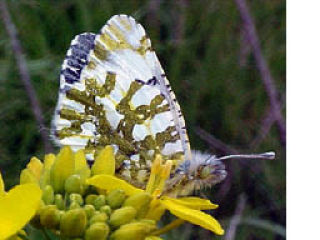Several rare butterflies have been seen in the San Juan Islands. Only the Island Marble butterfly is found only in the islands and nowhere else!
The butterfly genus Euchloe—the Marbles—is found throughout the Northern Hemisphere. All Euchloe species look similar with greenish-gray marbling on yellow-white wings. There are five regionally distinct Euchloe species in Europe, but all feed mainly on wild European plants in the mustard family (Brassicaceae). There are also five regionally distinct Euchloe species in North America, and they too rely on wild native mustards. Three are found along the Pacific slope: the California Marble in southern Oregon and California; the Large Marble (E. ausonides) in northern Oregon, Washington State, and southern British Columbia; and the Northern Marble British Columbia and Alaska.
For reasons we do not yet understand, Marbles were never abundant in western Washington or the Salish Sea basin as a whole, and they seemed to have disappeared a century ago. The last Salish Sea Marble was reportedly collected in the Gulf Islands in 1908. But a routine State butterfly survey in 1998 netted several of them on south San Juan Island. This caused considerable excitement, and led to unsuccessful efforts to get the San Juan County population of Marbles protected as an endangered subspecies of the Large Marble.
Just how threatened are our Island Marbles? They have been seen at numerous locations on San Juan Island south of Friday Harbor, and Lopez south of Dill Road, but have been found consistently since 1998 only at American Camp, Cattle Point, and near Lopez School. In spring 2008 we found about a hundred Island Marble eggs on San Juan Island and barely 20 on Lopez. Most caterpillars do not survive to fly as adults. At most we can expect 200-300 adults to emerge next spring, countywide.
Is the Island Marble a local subspecies of the Large Marble—or perhaps just a recent introduction in a bale of hay from eastern Washington? The genetic relationships of San Juan County’s butterflies to other North American Euchloe have not yet been worked out. Our lab is working on it (without any government support, unfortunately).
Why do most Marbles worldwide lay their eggs on mustards? The caterpillars may gradually accumulate the irritating substances that mustards produce to discourage insects and birds—making the caterpillars also unpalatable to insects and birds! The fact that older Marble caterpillars develop bright yellow stripes is consistent with a warning to potential predators: “you really don’t want to eat me!”
But this leads to another puzzle. Island Marbles seem to prefer to eat two non-native mustards often found in old pastures, Brassica rapa campestris and Sisymbrium altissimum. Do these native North American butterflies find European mustards tastier than native mustards, or simply more readily available in the islands? No one knows.
Kwiáht and the Washington State Departments of Natural Resources and Fish and Wildlife are building Island Marble refuges at Cattle Point and Lopez School with plenty of Brassica rapa and protection from deer and human disturbance. Contact us if you are interested in helping save this beautiful threatened butterfly, and learn more about its real identity and origins!
For more information on Island Marble research and recovery, or to volunteer to help build butterfly refuges, contact Russel Barsh at RLBarsh@gmail.com or 468-2808.



